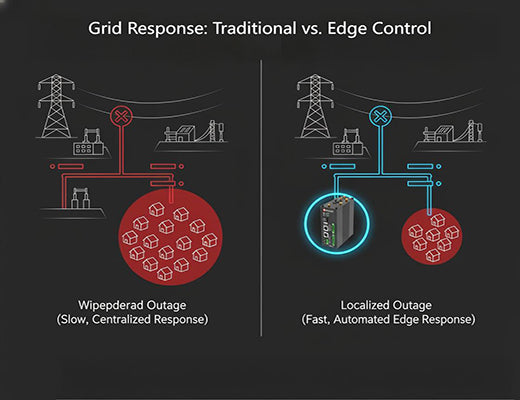
Powering the Future: How Edge Control is Revolutionizing the Smart Grid
|
|
Time to read 5 min
|
|
Time to read 5 min
This guide explains how edge control is revolutionizing the smart grid by moving intelligent decision-making from centralized control rooms to the grid's edge. By deploying powerful edge gateways at substations and on distribution lines, utilities can create autonomous, self-healing networks that detect and isolate faults in milliseconds. This decentralized approach to smart grid automation is critical for improving grid resilience, integrating renewable energy, and building the reliable energy infrastructure of the future.
In the smart grid, edge control is about creating autonomous, localized control loops to react to grid events instantly, without waiting for the central SCADA system.
It solves the critical challenge of latency. By making decisions locally, an edge gateway can isolate a fault in milliseconds, dramatically reducing the scope and duration of power outages.
Key applications include Distribution Automation (intelligent fault isolation) and Renewable Energy Management (local optimization of solar and battery storage).
This requires specialized hardware that is both incredibly rugged to survive the utility environment and powerful enough to run complex control logic, like the Robustel EG5120.
For decades, our electrical grid has operated on a simple, centralized model: if a tree branch falls on a power line, a breaker at a distant substation trips, plunging an entire neighborhood into darkness. An operator in a control room, miles away, then has to analyze the situation and manually reroute power. The process is slow, reactive, and results in extended outages.
What if the grid itself could "feel" the fault the moment it happened and heal itself in the blink of an eye?
Let's be clear: it can. This is the revolutionary promise of edge control in the smart grid. It's about distributing intelligence across the network, empowering the grid's edge to think and act for itself.

The traditional SCADA system is like the grid's "strategic brain"—excellent for overall supervision but too slow for tactical, real-time responses. Edge control places a "local commander"—a powerful industrial edge gateway—at critical points in the network.
The 'aha!' moment for utility engineers is realizing this architecture doesn't replace SCADA; it supercharges it. The edge gateway handles the instant, millisecond-level reactions, while the SCADA system remains in charge of high-level, supervisory control. This is the essence of smart grid automation.
The most impactful application of edge control is in creating a self-healing distribution network. This is often called FLISR (Fault Location, Isolation, and Service Restoration).
Integrating intermittent renewables like solar and wind is a huge challenge for grid stability. Edge control provides the local intelligence needed for smooth integration.

Edge control is the foundational technology for building the resilient, responsive, and decentralized power grid that the 21st century demands. It moves the grid from a model of slow, centralized reaction to one of instant, distributed intelligence. By deploying rugged, powerful, and secure industrial edge gateways, utilities can build self-healing networks, seamlessly integrate renewables, and provide a more reliable and sustainable energy supply for everyone.
Further Reading:
What is Edge Control? The Future of Real-Time Industrial AutomationA Buyer's Guide to Edge Products: Choosing the Right Hardware for Your ApplicationThe Core Hardware for Edge Control: From CPU/NPU to Industrial I/O
A1: A utility-grade router must have extreme hardware reliability, including a very wide operating temperature range and high levels of EMC (Electromagnetic Compatibility) immunity to survive the electrically noisy environment of a substation. It must also have robust software, including a full suite of security features (VPNs, Firewall) and support for specific utility communication protocols like DNP3 and IEC 60870-5-104.
A2: Yes, security is the highest priority. The edge control architecture can actually improve security. The edge gateway acts as a secure firewall, isolating the local OT network. All supervisory communication back to the central SCADA system is sent over a heavily encrypted VPN tunnel. Furthermore, the vendor's development process must be certified to standards like IEC 62443 to ensure the device is secure by design.
A3: The edge gateway acts as an intelligent, modern Remote Terminal Unit (RTU). It communicates with the central SCADA host using standard protocols (like DNP3 over IP), providing status updates and accepting high-level supervisory commands. The key difference is that it has the autonomy to act locally and instantly on its own, without waiting for the SCADA master.